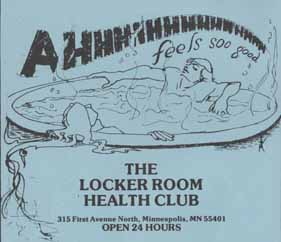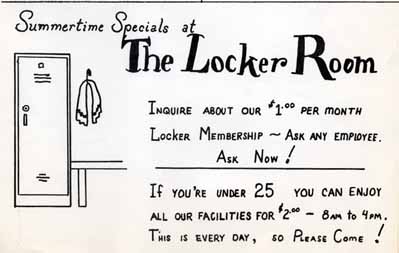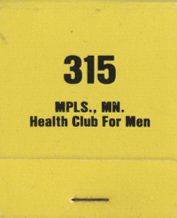Locker Room Baths
315 1st Avenue North, Minneapolis
| Locker Room Ad, 1980. courtesy of the Jean-Nickolaus Tretter Collection. |
The Locker Room was a a place of anonymous sex and cross-cultural encounters, where men could enter, pay a small price for a locker to store street clothes, and wander in a state of undress searching for available sex partners.
|
As time progressed, ageing bathhouses came under new ownership and discarded all pretense of non-sexual services. Instead, and amid a 1970s culture of unabashed sexuality, the bathhouses advertised their services in queer publications.
| The Locker Room began as an offshoot of Sutton’s Place, a gay bar located at 1st Ave N. and 7th St. (where the Target Center now stands). The bathhouse and bar eventually separated ways, and the bathhouse moved to a run-down warehouse.
|
Locker Room Ad, 1977. Courtesy of the Jean-Nickolaus Tretter Collection. |
The City of Minneapolis did not get the joke. Minneapolis Police, under the auspice of a “Vice Squad,” frequently raided the Locker Room Baths and arrested the employees, the owners, or the clientele.
| Locker Room matchbook, Courtesy of the Jean-Nickolaus Tretter Collection. |
These raids were so common that the Locker Room’s helpful staff printed escape pamphlets in the event of the arrests and, for a short time, the police and gay bathhouses achieved an unsteady truce.
|
This entry is part of:
Minneapolis/St. Paul, MN: 100 Queer Places in Minnesota History, (1860-2010)
(1)Tretter, Jean-Nickolaus. Interview with the author and Jacob Gentz. 1/16/2009.
(2)Williams, Marilyn T. Washing the Great Unwashed: Public Baths in Urban America: 1840-1920. Ohio: Ohio University Press, 1991.
(3)http://gaytubs.blogspot.com/2006/12/history-of-gay-bath-houses-blog.html. "THE LOCKER ROOM - MINNEAPOLIS 1976 - 1982 [sic]" comment submitted by "Greg" 1/24/2007
(4) Ritter, John. "New Ordinance may Close Bathhouse." Equal Time issue 152, 2/3/1988. Page 7.
(5)Ritter, John. "315 Health Club closes prior to ordinance." Equal Time news, Issue 157. 4/13/1988.


